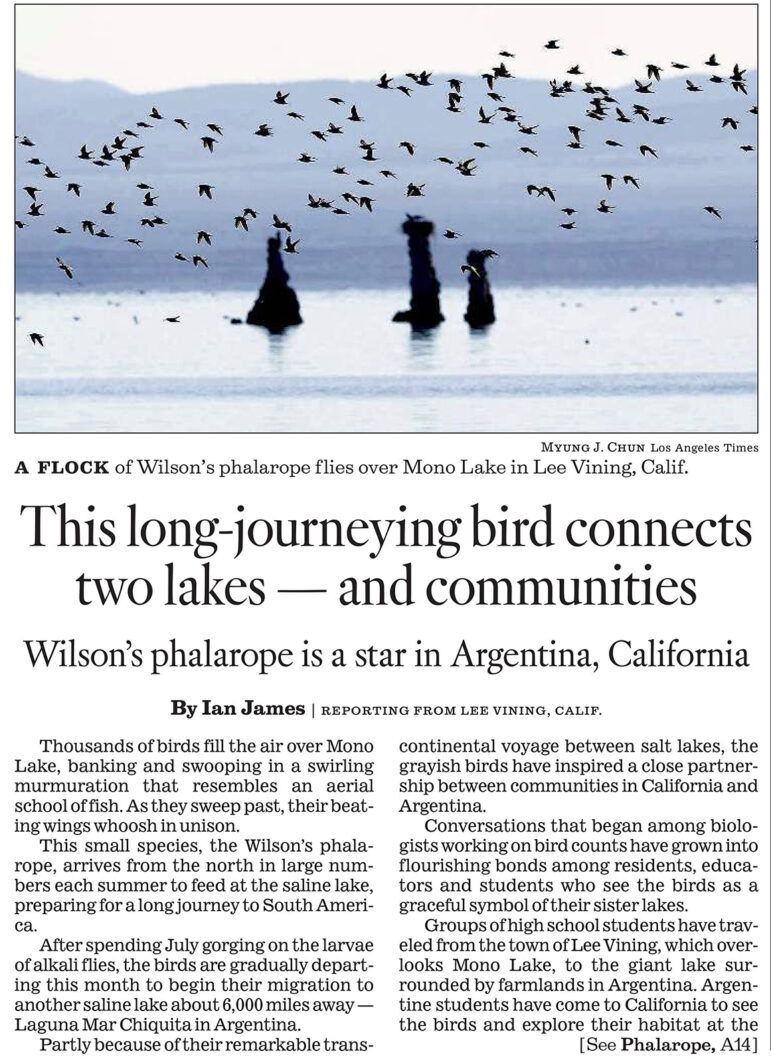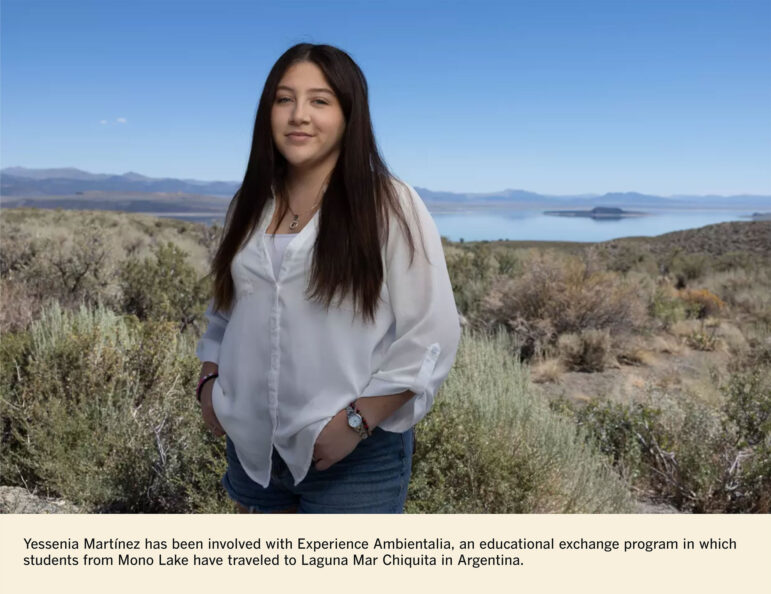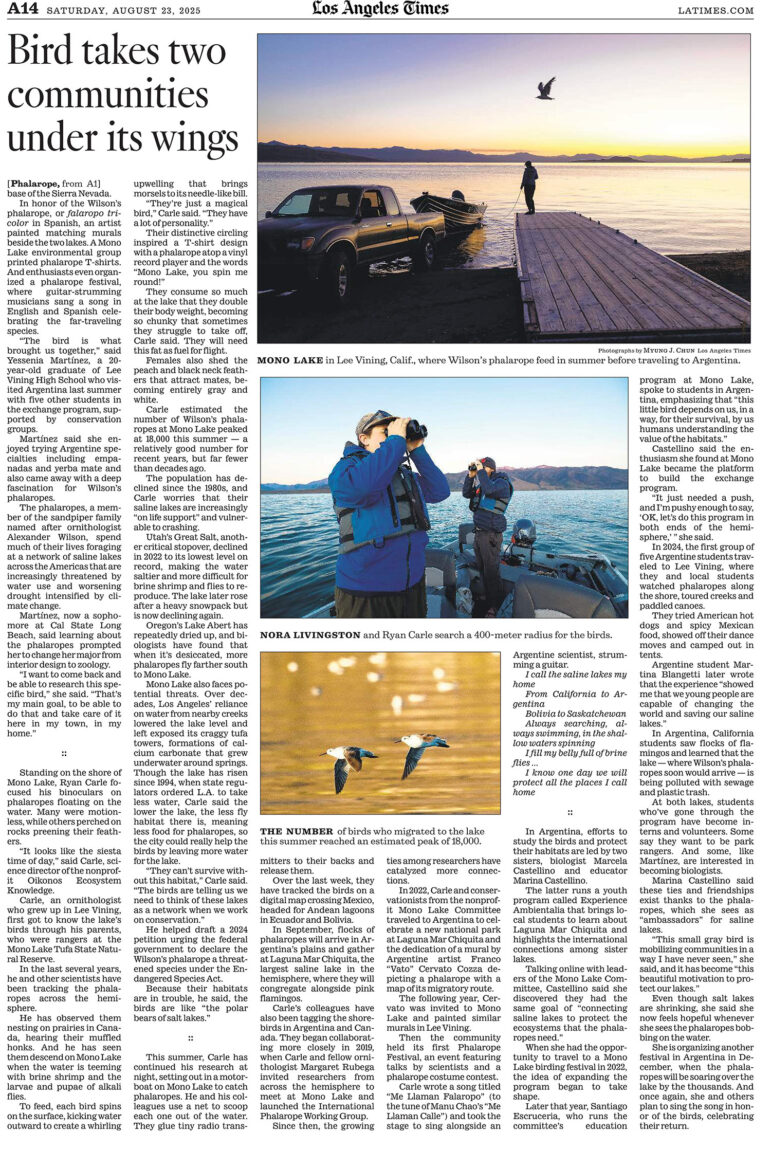
The phalaropes are at it again—this time beguiling Los Angeles Times writer Ian James to feature this “aerial school of fish,” the threatened saline lakes they depend on, and the people they’ve inspired to play a leading role in their protection. It’s a beautiful telling of the story, and a poignant call for action to heal Mono Lake—and saline lakes throughout the hemisphere.
The article, “A long-journeying bird connects lakes in California and Argentina—and two communities” first follows Ryan Carle, Science Director for Oikonos Ecosystem Knowledge, lead phalarope researcher, and phalarope-inspired singer-songwriter, who says. “They’re just a magical bird … They have a lot of personality.”

Carle estimated the number of Wilson’s phalaropes at Mono Lake peaked at 18,000 this summer — a relatively good number for recent years, but far fewer than decades ago.
The population has declined since the 1980s, and Carle worries that their saline lakes are increasingly “on life support” and vulnerable to crashing.
Utah’s Great Salt, another critical stopover, declined in 2022 to its lowest level on record, making the water saltier and more difficult for brine shrimp and flies to reproduce. The lake later rose after a heavy snowpack but is now declining again.
Oregon’s Lake Abert has repeatedly dried up, and biologists have found that when it’s desiccated, more phalaropes fly farther south to Mono Lake.
Mono Lake also faces potential threats. Over decades, Los Angeles’ reliance on water from nearby creeks lowered the lake level and left exposed its craggy tufa towers, formations of calcium carbonate that grew underwater around springs. Though the lake has risen since 1994, when state regulators ordered L.A. to take less water, Carle said the lower the lake, the less fly habitat there is, meaning less food for phalaropes, so the city could really help the birds by leaving more water for the lake.
“They can’t survive without this habitat,” Carle said. “The birds are telling us we need to think of these lakes as a network when we work on conservation.”
The article also highlights Experience Ambientalia, an international environmental education and leadership program co-organized by the Mono Lake Committee and Fundación Líderes de Ansenuza at Laguna Mar Chiquita, Argentina.
Experience Ambientalia is a year-round program of local stewardship activities that creates local connections and roots, and pursues deeper knowledge of the students’ lakes and how to play an effective role in their protection.

Reporter Ian James spoke with Lee Vining High School graduate Yessenia Martínez, who is a student at Cal State Long Beach and was inspired by phalaropes to major in zoology.
“The bird is what brought us together,” said Yessenia Martínez, a 20-year-old graduate of Lee Vining High School who visited Argentina last summer with five other students in the exchange program, supported by conservation groups.
The Ambientalia students are keenly aware that it is only by working together that we will preserve the biodiversity critical to both California and Argentina.
Mono Lake is only halfway to the level mandated for protection of Mono Lake’s hemispherically significant biodiversity—including phalaropes. Chronic and current low levels impair the food supply for phalaropes and other migratory and nesting birds.
In 2024 the Board of Commissioners of the Los Angeles Department of Water & Power (DWP) approved a motion to integrate “biodiversity initiatives and nature-based solutions throughout the Department’s operations.” However, DWP continues to keep the lake from rising by maximizing annual water diversions, even breaking the promise of Mayor Karen Bass in 2024 to not increase water exports. The Committee is working to make sure Mono Lake is rising by reducing water diversions to ensure the lake mandate is implemented.
“The polar bears of salt lakes”
The LA Times article is both stark and inspiring. Marina Castellino, the program leader at Laguna Mar Chiquita spoke of the origins of the partnership.

Talking online with leaders of the Mono Lake Committee, Castellino said she discovered they had the same goal of “connecting saline lakes to protect the ecosystems that the phalaropes need.” …
Later that year, Santiago Escruceria, who runs the committee’s education program at Mono Lake, spoke to students in Argentina, emphasizing that “this little bird depends on us, in a way, for their survival, by us humans understanding the value of the habitats.”
Castellino said the enthusiasm she found at Mono Lake became the platform to build the exchange program.
“It just needed a push, and I’m pushy enough to say, ‘OK, let’s do this program in both ends of the hemisphere,’” she said.
Marina Castellino said these ties and friendships exist thanks to the phalaropes, which she sees as “ambassadors” for saline lakes.
“This small gray bird is mobilizing communities in a way I have never seen,” she said, and it has become “this beautiful motivation to protect our lakes.”
Hidden within the story of the phalaropes and the people they’ve inspired, is another story that James wrote about in a recent article, “Decades ago, LA was ordered to take less water to save Mono Lake. But the city remains far from a key goal.” Mono Lake is low because of DWP. DWP’s historic excessive diversions caused Mono Lake to lose half its volume and double in salinity. After the mandate from the state, the lake is only halfway to the healthy level and a decade overdue. Right now DWP’s diversions are holding Mono Lake back from rising to the healthy level mandated by the State of California, needed by the phalaropes to survive and, one might argue, vital for Los Angeles, too.
There is currently a petition seeking protection for the Wilson’s Phalarope under the Endangered Species Act. And this summer the Mono Lake Committee installed three new Motus arrays around Mono Lake to help track the movement of migratory birds using tiny radio tags.
If you haven’t yet seen the phalaropes at Mono Lake, July–August are the most likely times to find them. And, if all of this phalarope phanaticism isn’t enough to convince you to come see them for yourself, try this video of phalaropes flocking around a canoe tour at Mono Lake.
Top photo courtesy of Sherburn Sanborn.
